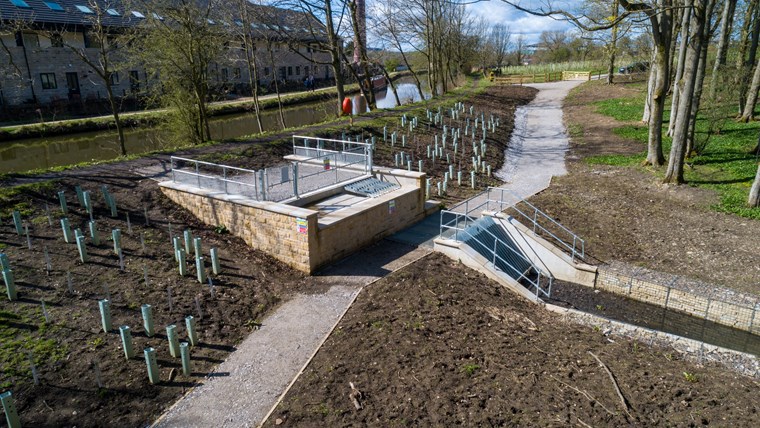Series of water management works in Aireville Park complete

The culverts have been rebuilt. Photo credit: Chapman Brown Photography
An important scheme to better manage the flow of water along Gallow Syke in Aireville Park, Skipton, and provide additional protection to premises downstream is now complete.
Led by Craven District Council to improve the flow of water along Gallow Syke in Aireville Park, the scheme, which is part of a larger £5million regeneration scheme for the town, began in 2020. It has seen the rebuilding of two culvert entrances so water can be stored temporarily during flood events, delaying its release and reducing the impact on the industrial areas around Engine Shed Lane and Ings Lane.
Gallow Syke is a small river and tributary of the River Aire, located to the west of Skipton town centre. Principally in an open channel passing through areas of woodland and grassland, Gallow Syke flows in a southerly direction from north of Gargrave Road, near Aireville Grange, through Aireville Park.
The river then culverts under the canal and areas of residential and industrial land before joining with Ings Beck at the junction of Broughton Road and Ings Lane. Whilst flowing through Aireville Park, Gallow Syke passes through two main culverts – the first under the access road serving Aireville Park and the second where the river exits the park under the Leeds & Liverpool Canal.
Prior to this work, the inlet to both culverts were in poor conditions with inadequate trash screens which regularly became obstructed with debris and, through being redesigned had potential to better support management of water downstream.

What the site was like before. Photo credit: Chapman Brown Photography
At both locations the inlets to the culverts have been rebuilt with new trash screens, safer walkways for maintenance and materials to help the structure blend with semi-rural surroundings. In addition, the inlet to the culvert has been physically restricted in size. In normal flows, this restriction will have no impact on the watercourse, however, during periods of heavy rainfall, the restriction will manage the flow of water downstream. Over time this water will then drain away through a controlled approach helping to reduce the amount of water flowing into Ings Beck.
In addition to rebuilding of the culvert entrances 700 trees and shrubs have been planted at the site to compensate for the trees, which had to be removed. The planting of the new trees will help to reduce areas of bare ground and silt being washed downstream.
Designed by the engineering consultancy ‘WSP’ and constructed by contractors Galliford Try, the scheme is an important part of the delivery of the £5million Skipton Employment and Housing Growth scheme, funded by the Government’s Local Growth Fund, awarded by the York & North Yorkshire Local Enterprise Partnership (Y&NY LEP).

Commenting on the completion of the scheme, Cllr Simon Myers, lead member for Enterprising Craven and Chairman of Craven District Council, said: “The crucial works carried out is set to contribute to reducing the risk of flooding for homes and businesses in the west of Skipton, and will also contribute to the wider scheme, planned to improve vehicle connectivity around Engine Shed Lane, Ings Lane and Wyvern Park. We would like to thank residents for their patience and cooperation while we have been building these vital works.”
David Dickson, Chair of the York & North Yorkshire Local Enterprise Partnership Joint Assets and Infrastructure Board, added: “Flood resilience is crucial for economic growth, so we’re pleased to see the completion of these works. This is an important component of a wider programme in Skipton focusing on business, employment and housing growth, which the York & North Yorkshire Local Enterprise Partnership secured just under £6m of Local Growth Fund towards a further £20million of infrastructure investment, ahead of future commercial developments.”

